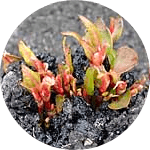Montbretia Removal & Control

The overview
Common Name: Montbretia
Latin name: Crocosmia x crocosmiiflora
In Detail
- Monbretia is a hybrid of species originating from South Africa, the hybrid was first introduced from France to the UK in 1880 as a garden plant, escaping into the wild in 1911. It quickly spread throughout the 20th Century.
- Once established the species can dominate areas outcompeting native flora.
- Bulblike organs called corms provide the plant with energy, the plant is able to regenerate from this material.
- The plant is widespread over much of the UK but more common in western areas.
Who we help
We have a long track record of managing some of the most complex sites in the country and have worked with the Environment Agency on several large flood alleviation projects, as well as providing advice to the majority of house builders and developers in the UK.
Click here to view who we help







Identification
- Smooth upright bright green leaves less than 3cm wide are present from spring to autumn, these form dense stands which can cover large areas. The plant grows to 60cm tall.
- During the winter leaves die and are brownish in colour, with dead flowering stems and seed heads.
- Flowers are orange in colour forming nodding clusters.
- Corms are present underground at the base of the plant, and can be used to identify the species from other similar looking plants.
What’s the problem?
- Monbretia is non-native species which can quickly out compete native plants forming dense clusters of growth.
- The plant spreads by rhizomes and rarely by seed.
- Legal implications if allowed to spread onto neighbouring land.
What are the Legal Implications? *England
- Listed as a Schedule 9 species under the Wildlife and Countryside Act 1981.
- It is an offence to plant or allow to spread onto adjacent land and into the wild.
- Possible fines and prison sentence under the Wildlife and Countryside Act 1981.
- It is not an offence to have Monbretia on your land and you do not need to notify anyone on the presence of this species.
- Soils containing Monbretia are classified as controlled waste and should be disposed of at licensed landfill.
Control Methods
Mechanical Control
- Plants can be dug out but it is essential that all the plant material and corms are removed. If corms are broken up or accidentally left they can produce new plants potentially making the problem worse.
- Excavated material should be removed from site to licensed landfill as controlled waste, or dealt with on site in waste management areas or buried.
Chemical Control
- Infestations can be effectively treated with herbicide whilst the plants are actively growing
When treating large areas, a suitable grass and forb mix should be sown to prevent bare ground and colonisation of other unwanted species.
If you have concerns over Monbretia on your land, if you are unsure of your legal responsibilities, or, if you would like a quotation for control, please contact one of our specialist surveyors. Treatment costs start at £380.00 + VAT.

Where we have worked
We operate nationwide with a Rapid Response Team on standby 7 days a week, to deal with the most urgent client enquiries.
We’re a dedicated team of professionals who share a great deal of experience. We invest heavily in the continual training of all our employees, ensuring you always have a highly qualified team working on your project with the latest industry accreditations.
Our process

1. Identify
Our first step is to identify if you have an invasive plant. For a quick ID, you can send us some photos. Alternatively, we can carry out a full site survey to confirm the extent of the infestation.

2. Solution
We will provide a range of treatment options individually tailored depending on your site requirements.

3. Quote
A detailed breakdown of costs for each phase of treatment will be provided, including on-going monitoring programmes with insurance backed guarantees.

4. Removal
Our experienced and professional in-house teams will carry out the treatment to the highest of standards to achieve full eradication. All works are carried out in accordance with the INNSA Code of Practice.

5. Treatment
A range of treatment solutions are available, from in-situ herbicide application to excavation and removal or burial. All carried out in-house by our experienced team.

